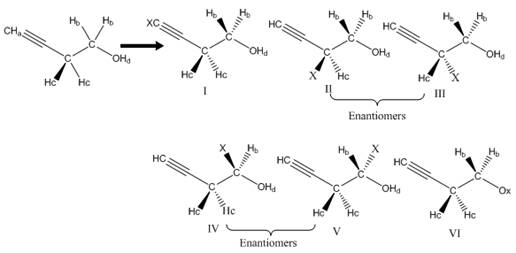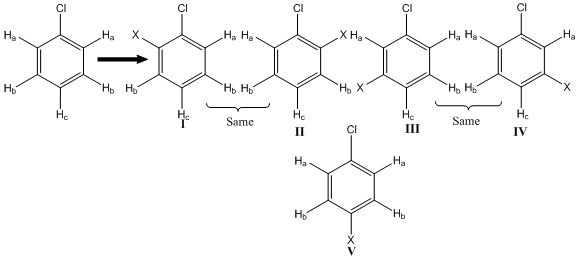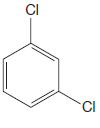
Concept explainers
(a)
Interpretation:
How many chemically distinct H atoms are in the given molecule is to be determined.
Concept introduction:
Sometimes, it is not immediately obvious whether certain hydrogen atoms in a molecule are chemically distinct. In such cases, the chemical distinction test is used. Chemical distinction test is a test in which the complete structure of the molecule is to be drawn in which and only the hydrogen atom is replaced by an imaginary “X” atom. There should be one X-substituted molecule for each hydrogen atom being tested. If the chemical distinction test yields enantiomers, then the corresponding hydrogen atoms are said to be enantiotopic. If the test yields diastereomers, then the corresponding hydrogen atoms are said to be diastereotopic.
Answer to Problem 16.8P
There are two types of chemically distinct H atoms in the given molecule.
Explanation of Solution
The given molecule is:

There are five H atoms in the above compound. These H atoms are not easily identified whether they are distinct or similar. Thus, the chemical distinction test is used here.
All H atoms in the compound are replaced by “X”; all possible structures are as shown below:

Molecules I and II are enantiomers i.e. mirror images of each other. According to chemical distinction test, these H atoms are not chemically distinct. Molecules I/II and III are constitutional isomers, these H atoms are chemically distinct. Therefore, there are two distinct types of protons, one for
Number of chemically distinct H atoms in the given molecule is determined using a chemical distinction test.
(b)
Interpretation:
How many chemically distinct H atoms are in the given molecule is to be determined.
Concept introduction:
Sometimes, it is not immediately obvious whether certain hydrogen atoms in a molecule are chemically distinct. In such cases the chemical distinction test is used. Chemical distinction test is a test in which the complete structure of the molecule is to be drawn in which and only the hydrogen atom is replaced by an imaginary “X” atom. There should be one X-substituted molecule for each hydrogen atom being tested. If the chemical distinction test yields enantiomers, then the corresponding hydrogen atoms are said to be enantiotopic. If the test yields diastereomers, then the corresponding hydrogen atoms are said to be diastereotopic.
Answer to Problem 16.8P
There are four types of chemically distinct H atoms in the given molecule.
Explanation of Solution
The given molecule is:

There are six H atoms in the above compound. These H atoms are not easily identified as distinct or similar. Thus, the chemical distinction test is used here.
All H atoms in the compound are replaced by “X”; all possible structures are as shown below:

Molecules I, II/III, IV/V, and VI are constitutional isomers. According to chemical distinction test, these H atoms are chemically distinct. Molecules II and III also IV and V are enantiomers; these H atoms are not chemically distinct according to the test. Thus, there are total four types of chemically distinct protons in the given molecule b.
Number of chemically distinct H atoms in the given molecule are determined using chemical distinction test.
(c)
Interpretation:
How many chemically distinct H atoms are in the given molecule is to be determined.
Concept introduction:
Sometimes, it is not immediately obvious whether certain hydrogen atoms in a molecule are chemically distinct. In such cases the chemical distinction test is used. Chemical distinction test is a test in which the complete structure of the molecule is to be drawn in which and only the hydrogen atom is replaced by an imaginary “X” atom. There should be one X-substituted molecule for each hydrogen atom being tested. If the chemical distinction test yields enantiomers, then the corresponding hydrogen atoms are said to be enantiotopic. If the test yields diastereomers, then the corresponding hydrogen atoms are said to be diastereotopic.
Answer to Problem 16.8P
There are three types of chemically distinct H atoms in the given molecule.
Explanation of Solution
The given molecule is:

There are five H atoms in the above compound. These H atoms are not easily identified as distinct or similar. Thus, the chemical distinction test is used here.
All H atoms in the compound are replaced by “X”; all possible structures are as shown below:

Molecules I and II, and also III and IV are the same molecules. Molecules I/II, III/IV, and V are consititutional isomers. These H atoms are distinct according to the chemical distinction test. Therefore, there are three types of chemically distinct H atoms in the given molecule c.
Number of chemically distinct H atoms in the given molecul, are determined using chemical distinction test.
(d)
Interpretation:
How many chemically distinct H atoms are in the given molecule is to be determined.
Concept introduction:
Sometimes, it is not immediately obvious whether certain hydrogen atoms in a molecule are chemically distinct. In such cases the chemical distinction test is used. Chemical distinction test is a test in which the complete structure of the molecule is to be drawn in which and only the hydrogen atom is replaced by an imaginary “X” atom. There should be one X-substituted molecule for each hydrogen atom being tested. If the chemical distinction test yields enantiomers, then the corresponding hydrogen atoms are said to be enantiotopic. If the test yields diastereomers, then the corresponding hydrogen atoms are said to be diastereotopic.
Answer to Problem 16.8P
There are three types of chemically distinct H atoms in the given molecule.
Explanation of Solution
The given molecule is:

There are four H atoms in the above compound. These H atoms are not easily identified s distinct or similar. Thus, the chemical distinction test is used here.
All H atoms in compound are replaced by “X”; all possible structures are as shown below:

Molecules II and III are the same molecule. Molecules I, II/III and IV are constitutional isomers. According to the chemical distinction test, these H atoms are distinct. Therefore, there are three types of chemically distinct H atoms in the given molecule d.
Number of chemically distinct H atoms in the given molecule is determined using the chemical distinction test.
(e)
Interpretation:
How many chemically distinct H atoms are in the given molecule is to be determined.
Concept introduction:
Sometimes, it is not immediately obvious whether certain hydrogen atoms in a molecule are chemically distinct. In such cases the chemical distinction test is used. Chemical distinction test is a test in which the complete structure of the molecule is to be drawn in which and only the hydrogen atom is replaced by an imaginary “X” atom. There should be one X-substituted molecule for each hydrogen atom being tested. If the chemical distinction test yields enantiomers, then the corresponding hydrogen atoms are said to be enantiotopic. If the test yields diastereomers, then the corresponding hydrogen atoms are said to be diastereotopic.
Answer to Problem 16.8P
There is one type of chemically distinct H atom in the given molecule.
Explanation of Solution
The given molecule is:

There are four H atoms in the above compound. These H atoms are not easily identified as distinct or similar. Thus, the chemical distinction test is used here.
All H atoms in compound are replaced by “X”; all possible structures are as shown below:

All molecules, I, II, III and IV are same. These H atoms are not distinct according to the chemical distinction test. Therefore, there is only one type of chemically distinct H atoms in the given molecule e.
Number of chemically distinct H atoms in the given molecule is determined using chemical distinction test.
(f)
Interpretation:
How many chemically distinct H atoms are in the given molecule is to be determined.
Concept introduction:
Sometimes, it is not immediately obvious whether certain hydrogen atoms in a molecule are chemically distinct. In such cases the chemical distinction test is used. Chemical distinction test is a test in which the complete structure of the molecule is to be drawn in which and only the hydrogen atom is replaced by an imaginary “X” atom. There should be one X-substituted molecule for each hydrogen atom being tested. If the chemical distinction test yields enantiomers, then the corresponding hydrogen atoms are said to be enantiotopic. If the test yields diastereomers, then the corresponding hydrogen atoms are said to be diastereotopic.
Answer to Problem 16.8P
There are three types of chemically distinct H atoms in the given molecule.
Explanation of Solution
The given molecule is:

There are five H atoms in the above compound. These H atoms are not easily identified as distinct or similar. Thus, the chemical distinction test is used here.
All H atoms in compound are replaced by “X”; all possible structures are as shown below:

Molecules I and II, and also III and IV are the same molecule. Molecules I/II and III/IV are constitutional isomers. According to the chemical distinction test, these H atoms are chemically distinct. Therefore, there are three types of chemically distinct H atoms, two from the
Number of chemically distinct H atoms in the given molecule is determined using chemical distinction test.
Want to see more full solutions like this?
Chapter 16 Solutions
ORG.CHEM W/TEXT+SOLU.MANUAL
- Problem What amount (mol) of each ion is in each solution?(a) 5.0 mol of ammonium sulfate dissolved in water(b) 78.5 g of cesium bromide dissolved in water(c) 7.42×1022 formula units of copper(II) nitrate dissolved in water(d) 35 mL of 0.84 M zinc chloridePlan We write an equation that shows 1 mol of compound dissociating into ions. (a) We multiply the number of moles of ions by 5.0. (b) We first convert grams to moles. (c) We first convert formula units to moles. (d) We first convert molarity and volume to moles.arrow_forwardFor problem 3, why does N keep its electrons in addition to taking the H+ from the other molecule? Didn't it give its electrons to the other molecule?arrow_forwardThe molecule shown here has quite a large dipole, as indicated in its electrostatic potential map. Explain why.Hint: Consider various resonance structures.arrow_forward
- What is the hybridizarion of the atom labeled with arrow in each of the following molecules?arrow_forwardSee attached picture. Question.) Below is the NMR spectra and molecular formula for a molecule. Draw the complete structure in the box to the right below. All the atoms in each molecule are closed shell (octets) and uncharged. Lack of IR data does not mean that a specific functional group is not present in the molecule.arrow_forwardSolve correctly please, all subparts needarrow_forward
- Please draw a more stable resonance structure for the following molecule. Use a curved arrow to show how to transform the original structure to the new one and please specify charges.arrow_forwardPlease solve it with explanationarrow_forwardDraw the resonance structure for the following molecule: Just started with resonance, where would the arrows go? I'm unsure of this problem.arrow_forward
 Organic Chemistry: A Guided InquiryChemistryISBN:9780618974122Author:Andrei StraumanisPublisher:Cengage Learning
Organic Chemistry: A Guided InquiryChemistryISBN:9780618974122Author:Andrei StraumanisPublisher:Cengage Learning
